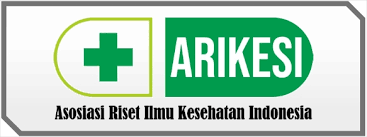Relationship between Education, Sex, and Age with Refractive Errors at DR. Wahidin Soedirohusodo General Hospital
Abstract
The prevalence of refractive error and its relationship with education, age and sex at DR. Wahidin Soedirohusodo general hospital have not been comprehensively assessed. The aim of this study was to examined the distribution and risk factor of refractive errors at DR. Wahidin Soedirohusodo general hospital. Methods of this study used population based cross-sectional study. Respondents were interviewed and underwent standardised clinical eye examinations. Refractive error was determined by an automatic refraction device. Refractive errors are myopia, hyperopia and astigmatism. Myopia and hyperopia were defined as spherical equivalent of -0.50/+0.50 diopter (D) or worse, respectively; astigmatism was defined as cylindrical error >0.50 D. Total of 1760 patients with refractive error from January 2016 to January 2018 with 700 or 39,8% males and 1060 or 60.2% females. Based on the cross-tabulation output, it is known that the respondents with the most elementary level of education experienced mild hypermetropy (10.2%), the junior high school education experienced mild myopia (6.8%), high school and bachelor education experienced mild myopia (8%). Age 6-15 years experienced the most myopia compositus astigmatism (5.7%), 16-25 years mild myopia (10.2%), 26-35 years mild myopia (4.5%), 36-45 years mild myopia (10.2%), 46-55 years mild hypermetropia (10.2%) and 56-65 years mild hypermetropia (5.7%). Kruskal Wallis test it is known that the sig value obtained = 0,000 indicates that there are differences in refractive abnormalities based on education and age. Chi square sig value obtained is 0.021, indicating that there is a relationship between sex and refractive errors. Multivariate analysis revealed female subjects inhibited the risk of mild myopic by 0.157 times the male subjects and simple myopia astigmatism by 0.082 times the male subjects. The relationship of myopia, astigmatism and hypermetropia with age and education is not significant. The risk factor of mild myopia and simple myopia astigmatism decrease in female than male. These findings may help clinicians to better understand the patterns of refractive error and planning for preschool vision-screening programs.
Keywords
Full Text:
PDFReferences
Bastanta, T, 2010. Prevalensi Kelainan Refraksi di Poliklinik Mata RSUP H. Adam Malik Medan dari 7 Juli 2008 sampai 7 Juli 2010. Universitas Sumatera Utara. Medan.
Fauziah MM, Hidayat M dan Julizar, 2014. Hubungan Lama Aktivitas Membaca dengan Derajat Miopi pada Mahasiswa Pendidikan Dokter FK Unad. Jurnal Kesehatan Andalas. Universitas Andalas.
Fricke TR, Holden BA, Wilson DA, Schlenther G, Naidoo KS, Resnikoff S, Frick KD, 2012 Global cost of correcting vision impairment from uncorrected refractive error. Bull World Health Organ. Oct 1; 90(10):728-38.
Irawan AF, 2015. Gambaran Deskriptif Pasien Kelainan Refraksi Di Rumah Sakit PHC Surabaya Periode Januari-Juni 2015. Skripsi. Fakultas Kedokteran. Universitas Katolik Widya Mandala Surabaya. Hal 2.
Isa MM, 2012. Karakteristik Penderita Kelainan Refraksi di Rumah Sakit Umum Daerah Dr. Pringadi Medan dari 1 Januari sampai 31 Desember 2012. Universitas Sumatera Utara. Medan.
Kalangi W, Rares L, dan Sumual V, 2016. Kelainan Refraksi di Poliklinik Mata Prof. Dr. R. D Kandau Manado Periode Juli 2014-Juli 2016. Jurnal Kedokteran Klinik. Universitas Sam Ratulangi.
Katz J, Tielsch JM, Sommer A, 1997. Prevalence and risk factors for refractive errors in an adult inner city population. Invest Ophthalmol Vis Sci. 38: 334–340.
Kempen JH, Mitchell P, Lee KE, Tielsch JM, Broman AT, Taylor HR, et al, 2004. The prevalence of refractive errors among adults in the United States, Western Europe, and Australia. Arch Ophthalmol. 122: 495–505.
Mahroo OA, Williams C, Hysi PG, Williams KM, Kailani O, Thompson J, et al, 2015. Interocular asymmetries in axial length and refractive error in 4 cohorts. Ophthalmology 122: 648–649.
Nazriati E dan Wijaya C, 2011. Hubungan Kelainan Refraksi Dengan Prestasi Akademik dan Pola Kebiasaan Membaca Pada Mahasiswa Fakultas Kedokteran Riau. Universitas Riau.
Pascolini D, and Mariotti SP. Global estimates of vision impairment: 2010. Br J Ophthalmol 2012; 96: 614–618.
Rifati L, Rosita T dan Hasanah N, Indrawati L, 2013. Kesehatan Indera. Badan Penelitian dan Pengembangan Kesehatan Kementerian Kesehatan RI. Riset Kesehatan Dasar. Jakarta. Badan Penelitian dan Pengembangan Kesehatan dan Kementerian Kesehatan RI. Hal 231.
Rodriguez NM and Romero AF, 2014. The Prevalence of Refractive Conditions in Puerto Rican Adults Attending An Eye Clinic System. Journal Opthometry. 7(3): 161-167.
Sewunet SA, Aredo KK, and Gedefew M, 2014. Uncorrected Refractive Error and Assosiated Factors Among Primary School Children in Debre Markos District, Northwest Ethiopia. BMC Opthalmology. 14:95.
Shrestha GS, Sujakhu D, Joshi P, 2011. Refractive Error Among School Children in Jhapa Nepal. J Optom. 4(2):49-55.
Wolfram C, Hohn R, Kottler U, Wild P, Blettner M, Buhren J, et al, 2014. Prevalence of refractive errors in the European adult population: the Gutenberg Health Study (GHS). Br J Ophthalmol. 98: 857–861.
World Health Organization (WHO). 2013. Universal Eye Health: a Global Action Plan 2014-2019. Spain: WHO. Hal 5-8.
DOI: http://dx.doi.org/10.30742/jikw.v8i1.479
Refbacks
- There are currently no refbacks.
Copyright (c) 2019 Kadek Dwipa Dyatmika, Nurmawanti Nurmawanti, Rini Kusumawar Dhany

This work is licensed under a Creative Commons Attribution-NonCommercial 4.0 International License.
Jurnal Ilmiah Kedokteran Wijaya Kusuma is licensed under a Creative Commons Attribution-NonCommercial 4.0 International License










